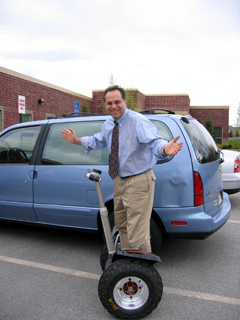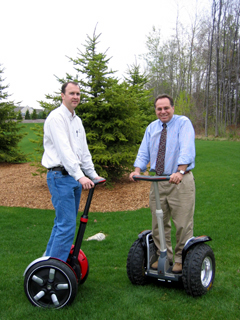The Segway Revolution?
Air Date: Week of May 6, 2005

Segway's chief engineer Doug Field (left) with host Bruce Gellerman (Photo: Jennifer Chu)
Three and a half years ago, the Segway was so top secret it needed a code name: Ginger. When it was finally revealed in December 2001, it was hailed as a device that would change the face of transportation. Host Bruce Gellerman visits the Segway headquarters in Bedford, New Hampshire to see how the human transporter has lived up to the hype.
Transcript
GELLERMAN: It’s Living on Earth. I’m Bruce Gellerman. Now we segue, not just from one story to the next, but to the future. To make the journey, we hope aboard a Segway.
[SOUND OF SEGWAY ROLLING BY]
O’DONNELL: You can now step up, and the key is to relax and let the machine balance for you. Just think forward, that's the easiest way to describe it.
GELLERMAN: The Segway looks like a pogo stick on two wheels. You stand on a platform in the middle. Its space-age innards contain state of the art gyroscopes and sensors, drive-by-wire controls and a whisper-quiet, pollution-free electric motor. When the Segway was first introduced in 2001, it was hailed and hyped as a device that would revolutionize human transportation. Certainly the technology is cutting edge but when I met Doug Field, Segway's chief engineer at the company's headquarters in Bedford, New Hampshire, he acknowledged that factoring in the human part of the revolution has taken a bit longer than expected.
FIELD: A market revolution takes time and when you introduce a new technology you need to wait and adapt and see how the people use the product and who sort of takes off with it. Because it’s not only based on how useful the product is in a particular market, but it’s about the psychology of people and how different groups behave. So, I think, I wouldn’t say it hasn’t gone as we had hoped or expected, but we’ve had to be very adaptable.
GELLERMAN: These market niches, it’s very interesting to see the way the product actually, the applications have evolved. Of course, I was reading the New York Times and they have Polo now.
FIELD: Uh-hm.
GELLERMAN: And you have the new device for golf.
FIELD: Right.
|
GELLERMAN: Where are the other horizons that you see for this? FIELD: Well… GELLERMAN: I can come up with 30 of them. FIELD: Exactly and we all do that and one of the biggest challenges in marketing and developing this business is deciding where to go. But police and security type markets are one of the most compelling markets that we’re really pushing for right now. A security officer or policeman is someone who needs to be present in a lot of places, be able to move quickly but still interact with their environment whether they’re inside an airport or on a street. Consumers are the other side of the business and some of them are using it for actual transportation. Some are using it for pure fun like the people who are doing polo and some are doing it for both. They ride it to work during the week and then play polo on it during the weekend. GELLERMAN: I noticed that, surprised a little bit, perhaps maybe not, France, a big market for you. How’s that? FIELD: Well, I think Europe in general is a very interesting market because, well for several reasons. First of all, the alternative, the automobile, is dramatically more expensive than it is in the U.S. In addition, a lot of the cities because they’re so much older were not designed and built around the automobile. So, the Europeans, I think, are used to adopting transportation technologies a little more quickly. You see a lot more public transportation there. We have a great partner in France also, Kiolis, who is working with us setting up kiosks where people can combine the product with the use of mass transportation to use it to get to their final destination. GELLERMAN: How does that work because this is that last mile that you’ve tried to link it seems to me from the home to the mass transit? FIELD: Right, right because mass transit has to choose to stop in one location. You can’t get everyone’s destination. And everyone wants to make an individual decision from that point forward. So, an individual can use the machine to get to their last mile by actually carrying it with them onto transportation. GELLERMAN: The idea, I can think of places where the kiss ‘n ride is, you just park your human transportation machine and hop on the train and you’re off to work. FIELD: Exactly, exactly, that is one potential vision. GELLERMAN: Okay. Good, I’ve got about a thousand more questions. Can we take it out for a spin? [SOUND OF SEGWAY MOTOR] GELLERMAN: Boy, you just hopped right on top of that. FIELD: Yeah, I’ve spent a little time on them. GELLERMAN: OK, so how do you turn it on? FIELD: So we’re going to turn it on using, this is an intelligent key that has a code in it that has to match the machine in order to start up. So it reads that key. So, to actually get it ready to stand on, what you want to do is level it out, okay, and then press and release that blue button. [BEEP] FIELD: Let go. Now you’ll sort of feel the machine come on. GELLERMAN: Oh my! It does. It feels like it’s really coming alive. FIELD: So, just pull it forward and backward a couple times and you’ll see, gently, gently, there you go. And you see how the wheels respond to that? GELLERMAN: Yeah, it kind of rolls back and forth as I push, huh? FIELD: Right. So you can now step up and the key is to just sort of relax and let the machine balance for you. Just think forward, that’s the easiest way to describe it. GELLERMAN: Think forward. It’s almost as if I don’t have to move it. It’s as if I do just think. FIELD: Exactly. And the reason is it’s really making use of the same gesture you would use as you would even before you take a step, if you think about walking you actually put your weight forward and you start to sort of tip and fall and then you take a step. Well, the machine is taking the step for you. So that almost subconscious motion that you make by tilting forward the machine is responding to and you forget about it very, very quickly. There’s no gas pedal, there’s no brake; it’s just under you responding. GELLERMAN: I’m going to go right, I’m going to go left. [SOUND OF SEGWAY MOTOR] GELLERMAN: So, right now how fast am I going? FIELD: One and a half, two miles an hour. GELLERMAN: Oh really, I feel like I’m zooming. FIELD: The top speed of the machine is 12 and a half miles per hour which is 20 kilometers per hour which is about the speed a fit person can run. GELLERMAN: So, you know, but the one thing, there is a nerd factor. You kind of look weird on it. FIELD: And any radical technology tends to have that effect. And it’s one of the reasons technologies do take time to be adopted. It is not something that any of us who were growing up would expect to see a wheeled machine do, ride along on two wheels balancing and standing upright. The funny thing is if you start talking to kids who have seen this over the last couple years they completely take it for granted. There’s nothing special about it and that’s probably something that’s associated with how technologies get adopted is the kids that were around when it got adopted gradually grew up and became consumers and start using it. GELLERMAN: Alright, I’m off. As I’m doing my George Jetson imitation and zooming around the company parking lot, I hover next to a man standing beside a brand-new, $5,000 Segway. GELLERMAN: Hi. Are you the owner if this Segway? SCHNEIDER: No, not yet. GELLERMAN: Not yet. SCHNEIDER: I’m working on it. GELLERMAN: Really, may I ask your name and where you’re from? SCHNEIDER: Sure, Bob Schneider, Randolph, Massachusetts. GELLERMAN: Uh-huh. And you came up here to look at one, buy one, think about one?  Bruce Gellerman rides a Segway. (Photo: Jennifer Chu) |
SCHNEIDER: I’m on the borderline here of purchasing one. Contemplating. GELLERMAN: Yeah? What would you use it for? SCHNEIDER: Uh, that’s the big question. Whether it’s recreation or whatnot. I don’t really have an exact use for it as of yet. GELLERMAN: So, this is the model you would get? This is a different model than the one I think I’m riding on. SCHNEIDER: Well, it’s what I can afford, basically. That’s what it comes down to. GELLERMAN: How long did it take you to learn how to use it? SCHNEIDER: Probably about a total of three minutes. GELLERMAN: Well, if you ever want to drag race I’m ready. SCHNEIDER: You’re ready? Okay. (laughter) GELLERMAN: Well, thank you very much. SCHNEIDER: Thank you. GELLERMAN: I feel absolutely comfortable on it. It’s really remarkable. FIELD: That’s the idea. There’s a quote, I believe it’s Arthur C. Clark, that any sufficiently advanced technology is indistinguishable from magic and it’s a great way to describe the machine I think. GELLERMAN: Well, Douglas Field, chief engineer of Segway, thank you very much. FIELD: Thank you. It's been a pleasure. GELLERMAN: Check out me on my Segway at LOE.ORG Links
|






